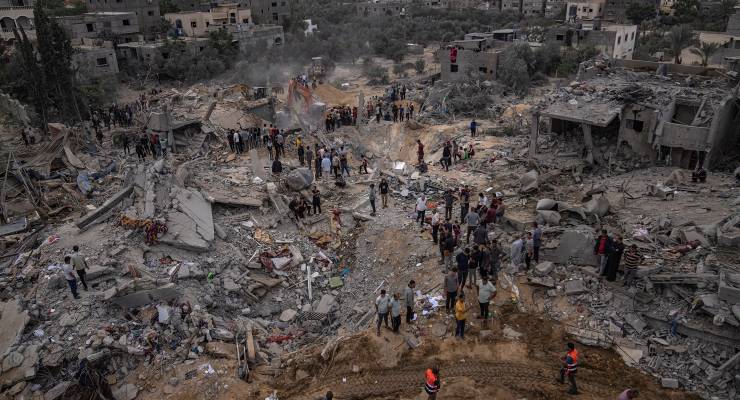
Water
Israel cut off cross-line water supplies to northern Gaza on October 9, two days after the October 7 attack.
For some decades, the population of the Gaza Strip has depended on about 100 desalination plants to supplement the cross-border supply. The desalination system, degraded by years of blockade of essential parts, has fallen apart completely due to a lack of fuel, with the last plant ceasing to operate in mid-October.
Residents have since been digging wells and consuming contaminated groundwater, or drawing from the aquifer, which was inundated with seawater some years ago.
On November 3, the IDF air force bombed water reserves in Rafah, the city at the southern end of the Gaza Strip, which it had instructed Gaza residents to flee to.
Food
Staple foods are running out in Gaza, with the United Nations Office for the Coordination of Humanitarian Affairs estimating that the supply of staple foods will run out in a matter of days. The Euro-Med Human Rights Monitor has accused Israel of sharply intensifying a “war of starvation” against the population.
By November 11, 821 trucks of food and other supplies had entered Gaza since the border was closed after the October 7 massacre, and then re-opened on October 21. This averages about 21 trucks a day, well below the 40 minimum required.
Of the 23 bakeries in Gaza, which fed a quarter of a million people each day, none are now operating. Five were directly targeted by bombing, and eight have been put out of use by bombing damage. The remainder have now run out of fuel and supplies.
Last week, Israel also bombed and destroyed Gaza’s fishing fleet on the shore, in the southern Rafah area, thus cutting off a source of protein.
Shelter
More than 10% of the housing stock in Gaza — 40,000 units — has been destroyed, with another 40%, or 220,000 units damaged, according to ReliefWeb. Around 1.5 million people are internally displaced. Three-quarters of a million are sheltering at the United Nations Relief and Works Agency (UNRWA).
Half a million people remain trapped in the combat zone of Northern Gaza, now that the Gaza Strip has been cut in two.
By October 20, at least five neighbourhoods in Gaza City had been completely levelled, including the prominent cultural area of Beit Hanoun.
The collapse of healthcare
Sixteen of 34 hospitals in Gaza are no longer operating, with the remaining 19 at partial operation levels, subject to fuel availability. Disinfectant materials have largely run out, as has fresh water sufficient for bathing wounds. Lethal triage has been implemented, with cardiac arrest patients left untreated and ventilators rationed.
Surgery, including amputations, on adults and children, is being performed without anaesthetic. Israel ordered the evacuation of 22 hospitals, including those specialising in dialysis patients and premature births. Re-establishing even a proportion of these facilities in the south would require a ceasefire.
Bombing of hospitals
Five hospitals had been bombed by the IDF air force before the weekend, on the claim that they are being used for Hamas operations. Some, such as the Indonesia Hospital, have denied this is the case. On the weekend, five more hospitals, including Al-Shifa, were targeted by both airstrikes and tanks and shelling on the ground. Israeli human rights organisation B’Tselem has argued that the war crime of locating in hospitals does not give Israel the right to bomb them.
Bombing of shelters
Israel has increased its bombing of shelters in the northern and middle zones of Gaza, with four bombed in the past few days. These included the Jabalia and Beach camps in northern Gaza, and the Bureij camp in the south, to which people had been directed.
Bombing of southern Gaza
There have been at least six airstrikes against southern areas to which Gazans have been directed to relocate. According to BBC Verify, the southern city of Khan Younis was struck on October 10 and 19, Rafah on October 11, and refugee camps struck on October 17, 18, and 25.
Destruction of universities and cultural heritage
Eleven out of 14 universities in Gaza have been completely destroyed. Fifty-four mosques and several Christian cultural centres have been demolished by bombing, including the 15th-century Ibn Othman mosque. The Church of Saint Porphyrios, built in the 12th century, was bombed and its current condition is unknown.
Targeting of journalists and their families
Close to 40 journalists and a number of Gaza Palestinian journalists’ families have now been killed in a four-week war — an extraordinary number. The International Federation of Journalists reports that working journalists widely believe that Israel is deliberately targeting journalists. More than 50 media outlet offices in Gaza have been bombed in the conflict.
Dying and rotting under rubble
With the ban on importing fuel into Gaza, it is becoming impossible to rescue the wounded trapped under rubble, whose cries for help are audible in many places. By the weekend it was estimated there were more than 2,300 bodies of the dead under the rubble. These are now beginning to rot away. Wild dogs have begun to eat the bodies in the streets.








Crikey encourages robust conversations on our website. However, we’re a small team, so sometimes we have to reluctantly turn comments off due to legal risk. Thanks for your understanding and in the meantime, have a read of our moderation guidelines.